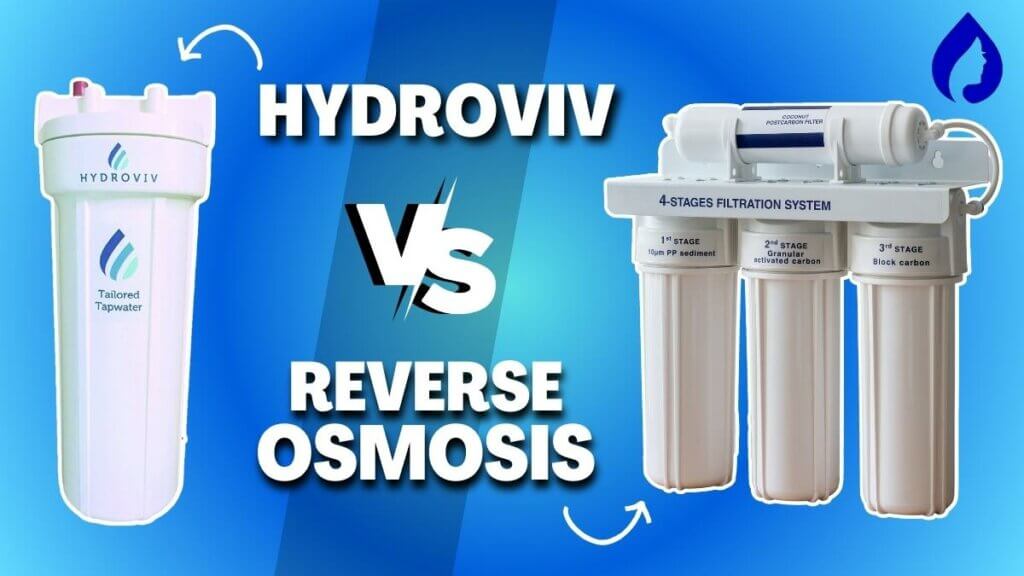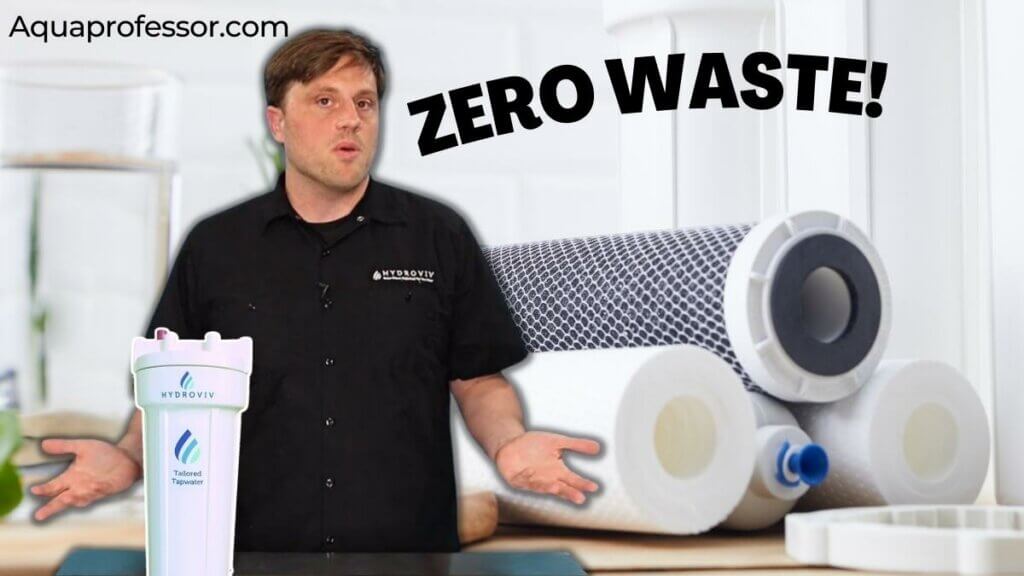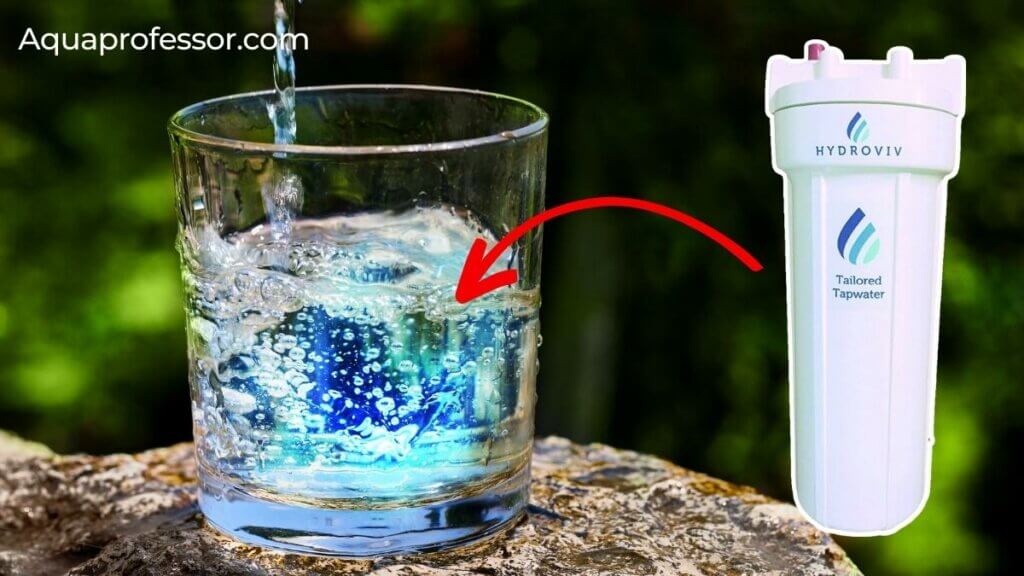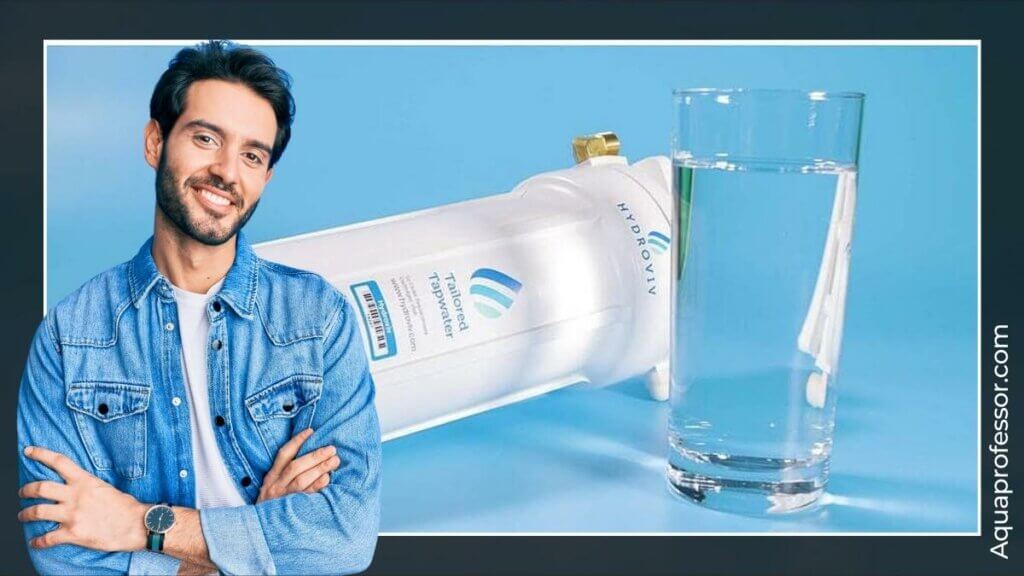
Hydroviv uses active carbon filters that do not waste water and reduce harmful contaminants such as lead and PFAS. Reverse Osmosis filters do waste water but can remove more contaminants than Hydroviv, like fluoride and nitrates.
Continue reading for a detailed comparison between Hydroviv and reverse osmosis water filters so that you can pick the best solution for your family.
🤔Is Hydroviv As Good As Reverse Osmosis?
| Basis | Hydroviv (Carbon Filter) | Reverse Osmosis |
|---|---|---|
| What Contaminants Can It Remove? | PFAS, Lead, Arsenic, Chromium 6, Hydrogen sulfide, VOCs, pesticides, cryptosporidium | PFAS, Lead, Arsenic, Chromium 6, Hydrogen sulfide, VOCs, pesticides, nitrates, bacteria, fluoride, sodium |
| What Contaminants It Can’t Remove? | Nitrates, iron, manganese, sodium, calcium & magnesium (hardness), fluoride | Iron, manganese, calcium & magnesium (hardness) |
| Water Wastage | No | It wastes water (average 4:1) |
| Water Flow Rate | 0.72-1 GPM | 0.05-0.7 GPM |
| Remineralization | Yes | Yes/Can be added |
| Maintenance (Filter replacement) | Once every 6 months | 6-12 months |
Here's How We Test Products At Aquaprofessor
💦Hydroviv Vs Reverse Osmosis System: Full Comparison
✅What Contaminants It Can Remove?

Both Hydroviv and RO can remove sediments, per- and poly-fluoroalkyl substances (PFAS), chromium-6, and heavy metals such as lead and arsenic.
The Hydroviv under-sink water filter system uses activated carbon, catalytic carbon, ceramic filters, and ion exchange technologies to reduce a wider range of contaminants like
- Hydrogen sulfide
- Volatile organic compounds (VOCs)
- Pesticides
- Chlorine
- Disinfection byproducts
- Other harmful chemicals.
Hydroviv stands out in providing targeted filtration solutions as it supplies customized water filters per the customer’s local water quality.
It is NSF-certified for standards 42 (reducing chlorine) and 53 (reducing lead, VOCs, and 50+ contaminants, including cryptosporidium).
On the other hand, Reverse Osmosis systems are highly effective at removing a wide variety of additional contaminants, including nitrates, fluoride, and bacteria.
They can also reduce sodium levels in softened water, providing complete purification.
RO filters contain a semi-permeable membrane with minute pore sizes and use reverse osmotic pressure to trap water impurities.
These units often come with a pre-filter to extend the lifespan of the membrane by trapping big impurities.
You will notice a great improvement in the taste of water. These under-sink water filters remove aesthetic contaminants and improve water taste.
❌What Contaminants It Can’t Remove?
While Hydroviv is excellent at removing a wide range of potential contaminants, it falls short when eliminating nitrates, high levels of iron and manganese, sodium, calcium, magnesium (hardness minerals), and fluoride.
Despite thorough filtration, RO systems may struggle to remove iron and hardness effectively. So, you will need an additional iron filter or a water softener to address these issues.
Also note that without a water softener, the RO filters might need replacements more frequently.
🚿Water Wastage

Hydroviv water treatment system is a sustainable choice as it employs carbon filters that do not waste water during filtration.
Traditional RO systems had a notable drawback regarding water wastage, with an average 4:1 drain-to-pure water ratio.
However, modern RO systems, like the Waterdrop G3P600, have significantly improved efficiency, reducing the ratio to 2:1.
RO filtration process wastes more water than it purifies because the trapped impurities on the reverse osmosis membrane are washed off using water.
This waste water is discarded through the drain line attracted to the system.
Also Read: Which Under-Sink Is Better: Hydroviv or Clearly Filtered?
💧Water Flow Rate
Hydroviv under-sink water filter is a POU system that boasts a water flow rate of 0.72-1 GPM with a filtration capacity of 720 Gallons of water, which is sufficient for most households.
RO systems offer a wide range of water flow rates, typically between 75 GPD and 1000 GPD.
The specific flow rate depends on the RO filter model and brand, allowing you to choose one that matches your water consumption needs.
🥛Water Remineralization

Hydroviv’s filtration process using active carbon media does not remove beneficial minerals from the water, eliminating the need for remineralization.
While RO filters remove minerals from the water, modern RO systems, like the Frizzlife PD600, offer alkaline demineralization.
This feature enhances the taste of the purified water along with some health benefits like keeping you hydrated.
⚙️Maintenance (Filter replacement)
Maintenance of Hydroviv involves periodic filter replacement, typically required every six months, to maintain optimal performance.
On the other hand, RO systems have a filter life of 1 year, after which they need to be replaced. Regular maintenance ensures that the system continues to deliver clean, safe water.
The cost of Hydroviv’s replacement filters is higher than other under-sink systems because it supplies its own customized replacement filters.
For ease of replacement, ensure sufficient space under the kitchen sink before the system’s installation process.
Remember that the replacement period is not fixed for every household and depends on your water quality and usage. The replacement process is often quick and user-friendly.
Filter media or membranes get saturated with water impurities over time. Thus, they stop filtering effectively and need immediate replacement to preserve your good water quality.
Also Read: Hydroviv VS Berkey: Which Is Best For You?
🧑⚖️Final Verdict: Is Hydroviv Better Than RO?

As you can see, Hydroviv and RO filters have advantages and limitations; choosing the right water filtration solution for your home comes down to your needs and priorities.
Hydroviv has a compact size and is an excellent choice if you’re primarily concerned about contaminants like lead, arsenic, and PFAS and want to minimize water wastage.
Why Hydroviv?
Hydroviv supplies personalized filters and is an eco-friendly option focusing on preserving healthy minerals in your local water supply.
It also offers a 30-day money-back guarantee to all its customers. However, you should explore RO filter options if you require nitrates removal or reduce sodium levels in softened water.
Reverse Osmosis systems, especially modern ones like the Waterdrop G3P600 and Frizzlife PD600, are well-suited for extensive water purification.
They effectively remove many contaminants, including nitrates and bacteria, making them ideal for those with multiple water quality concerns.
While RO does generate some wastewater that must be drained into an outlet, advanced technology has reduced this drawback.
Generally, RO filters have a lifespan of 1 year, after which they may need replacement.
To target the specific contaminants from varied water sources, we recommend you get your water tested by manual home kits or professional laboratories.
Testing completely reveals your water TDS composition and thus aids in picking suitable water purification systems.
Hydroviv VS Reverse Osmosis: FAQs
Is there anything better than reverse osmosis?
The suitability of Reverse Osmosis or alternative filtration methods depends on your water quality.
Softeners or iron filters may be more appropriate alternatives to reverse osmosis filtration if you face high water hardness or iron contamination.
Does Hydroviv actually remove PFAS?
Yes. The North Carolina State University study clearly reveals that Hydroviv effectively removes PFAS and other heavy metals, such as lead and arsenic, from the tap water.
Do Hydroviv filters work?
Yes, Hydroviv filters use active carbon filter technology, efficiently removing harmful contaminants such as lead, arsenic, and PFAS from your household cold water supply.
The NSF 42 and 53 certifications also support its claims to deliver healthy, clean water.
Does Hydroviv filter out good minerals?
No. Hydroviv’s carbon filters cannot remove essential minerals from the water supply, improving the water’s taste and quality.
Retaining these good water minerals, such as calcium, magnesium, sodium, potassium, zinc, fluoride, bicarbonates, and iron, is necessary to maintain good overall health.
Do reverse osmosis systems remove PFAS?
Yes, Reverse Osmosis systems can effectively remove PFAS (per- and polyfluoroalkyl substances) contaminants from water, ensuring safe and clean drinking water.
Sayan understands that access to clean water doesn’t have to be costly.
He strives to provide knowledge of water purification techniques in the simplest way possible so that we can lead a healthy life without breaking our bank.
